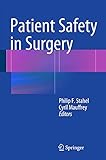Patient safety in surgery / edited by Philip F. Stahel, Cyril Mauffrey.
Tipo de material: TextoEditor: London : Springer London : Springer, 2014Descripción: xv, 513 páginas : 54 ilustraciones, 37 ilustraciones en colorTipo de contenido:
TextoEditor: London : Springer London : Springer, 2014Descripción: xv, 513 páginas : 54 ilustraciones, 37 ilustraciones en colorTipo de contenido: - texto
- computadora
- recurso en línea
- 9781447143697
- R1
Springer eBooks
Part 1. General Aspects -- 1: Quality Assessment in Surgery: Mission Impossible? -- 2. Incidence of 'Never Events' and Common Complications -- 3. Cognitive Errors -- 4. Diagnostic Errors -- 5. Technical Errors -- 6. The Missed Injury: A 'Preoperative Complication' -- 7. Non-Technical Aspects of Safe Surgical Performance -- 8. Postoperative Monitoring for Clinical Deterioration -- 9. Effective Communication- Tips and Tricks -- 10. Professionalism in Health Care -- 11. Accountability in the Medical Profession -- 12. The Role of the Surgical Second Opinion -- 13. Compliance to Patient Safety Culture -- 14. The Universal Protocol: Pitfalls and Pearls -- 15. Patient Safety in Graduate and Continuing Medical Education -- 16. Translation of Aviation Safety Principals to Patient Safety in Surgery -- 17. Handovers: The 'Hidden Threat' to Patient Safety -- 18. Public Safety-Net Hospitals- The Denver Health Model -- 19. Electronic Health Records and Patient Safety -- 20. Research and Patient Safety -- Part 2. The Surgeon's Perspective -- 21. The Surgery Morbidity and Mortality Conference -- 22. Reporting of Complications -- 23. Disclosure of Complications -- 24. Surgical Quality Improvement -- 25. Surgical Safety Checklists -- Part 3. Other Perspectives -- 26. The Anesthesia Perspective -- 27. The Nursing Perspective -- 28. The Patient's and Patient Family's Perspective -- 29. The Ethical Perspective -- 30. Patient Safety- A Perspective from the Developing World -- Part 4. Case Scenarios -- 31. Improving Operating Room Safety: A Success Story -- 32. Management of Unanticipated Outcomes: A Case Scenario -- 33. The Preventable Death of Michael Skolnik: An Imperative for Shared Decision-Making -- Epilogue -- Appendices.
Para consulta fuera de la UANL se requiere clave de acceso remoto.


